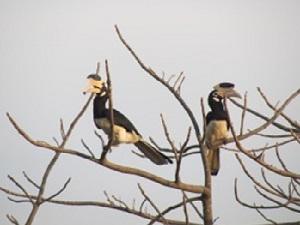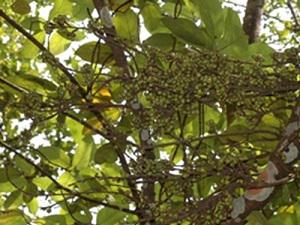Sneha Vijayakumar
The focus of this study is to understand the factors that determine the distribution and diversity of avian frugivores in the Western Ghats biodiversity hotspot, using a combination of field surveys, secondary data collection and ecological niche modelling. Understanding frugivore species distributions and their role in the ecosystem will facilitate conservation prioritization, and recommendations related to management of threatened species and disturbed habitats.

Pair of Malabar Pied Hornbills. © Shreekant Deodhar & Yashada Kulkarni
Understanding patterns of distribution and richness can markedly contribute to effective conservation of threatened species and habitats. Frugivorous birds are of particular interest since their richness and distribution are hypothesized to result from the diversity and distribution of food resources, which are influenced in turn by seasonality in climate. Playing a crucial role in maintaining forest dynamics and ecosystem functioning, they are especially vulnerable to hunting, deforestation and habitat fragmentation. This study is the first attempt to address the factors that determine the distribution of avian frugivores, using primary data, at the scale of the Western Ghats.

Ficus hispida. © Navendu Page
Across the world, a comprehensive knowledge base is available on frugivore ecology, especially at local spatial scales, but very little is known about the ecological and evolutionary processes that determine their occurrence at a broad scale. A recent analysis suggests that at a global scale, patterns of frugivore richness were found to be an effect of the spatial distribution and diversity of food resources, which were in turn an effect of variation in climate. At more local scales, community assembly of these frugivores could be influenced by biotic interactions as well. Analysing the implications of plant-frugivore interactions in response to changing climate regimes, in terms of how changes in their distributional range could affect ecosystem services they provide, is also crucial. This study aims to accurately delineate frugivore species ranges and understand their key associations with food resources in the Western Ghats biodiversity hotspot.
Using primary data collected from key biodiversity areas, accurate species distribution maps will be made using ecological niche modelling, taking into account preferred environmental variables and inter-specific interactions. Threatened frugivorous birds, including the Great Pied Hornbill, Nilgiri Wood Pigeon and Yellow Throated Bulbul, will be specifically monitored across the Western Ghats to assess their conservation status. In collaboration with forest departments, local NGOs and local communities, relevant conservation management plans will be developed. The data from this study will also contribute to other ongoing projects in the Western Ghats, forming a larger spatial database of species distribution that can be used as an important tool for conservation prioritization. An important capacity building component of this study will involve training local forest department staff as well as student volunteers in monitoring these birds as well as their food resources. Emphasizing on the effects of habitat fragmentation and changing climate on these species, long term conservation strategies can be developed by engaging policy makers and stakeholders.